114. Nikau mates at Te Hapu, no. 2
April 27, 2011 7:03 pm

We waved the torch over nearby palms on our way back from Gilbert’s Beach, at Te Hapu (www.tehapu.co.nz), a remote cattle station in Golden Bay. On a wide angle lens it is easier to stop the stars, which were more visible with the moon being blotted out by a cloudbank.
Having selected Direct sunlight light balance, I wasn’t happy with the coolness of the torchlight on the nikau – I’d assumed the LED beams were close to daylight colour temperature. Warming up the palms in post-pro gave the sky an unexpected boost, an effect I immediately liked. Also needing attention was the grass closer to the torch, which was a little overexposed.
I could easily have spent an hour here but further delay would have dragged on my good-natured company. Luckily I got the shot right first-off… how many times have I passed interesting scenes close to quarters, and thought “Well I can easily come back here another night”. All too often the following nights turn out to be too cloudy, or cold, or windy, and the photo is not worth the trouble.
Or if the evening’s not too dark nor too bright, and not a social night of the week, then you are too tired to summon the energy (“Not tonight, Josephine”). Or other nights you’re too well fed or wined, with other distractions for your leisure. In winter you leave a warm fire for the dubious pleasure of night photography in a chill breeze, while in summer you must wait too long for suitable darkness, then when you finally get out and about you remember the mosquito repellant is still at home.
I haven’t even started on the mechanics of setting up in the dark, never as simple as camerawork by daylight. Really, night photography takes far too much effort, and all for such uncertain results. Of course I thoroughly recommend it.
28mm, ISO 2000. 30 seconds at f4. Vivid picture control
Posted by Barney Brewster
Tags: Golden Bay, high ISO, long exposure, moonlight, Nelson, Nikon D700, stars, summer, trees, tripod, wide angle
Categories: Night photography
